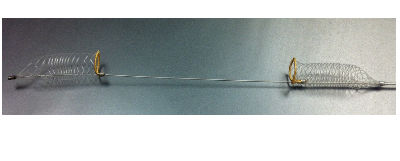
Now that mechanical thrombectomy for the treatment of acute ischaemic stroke is on its way to becoming well-established practice, new devices are beginning to emerge. One such device is a new clot retriever technology—Ncap device from NOHA—which has thus far been tested in animal models.
Ncap was introduced for the first time at the Live Interventional Neuroradiology and Neurosurgery Course (LINNC; 23–25 May, Paris, France) by Hesham Morsi (Baylor College of Medicine, Houston, USA), who invented the device. Morsi now speaks to NeuroNews about how Ncap differs from existing technology, its potential benefits and future testing.
Can you describe the new stent retriever technology?
This is a novel clot capture and removal device comprised of two clot capture expandable members deployed on either side of the impacted clot and manoeuvred toward each other to enclose around the clot with the distal capture member locking inside the proximal member for complete encapsulation and secure removal of the clot from the circulation.
How is it different from existing stent retriever technology?
With the existing stent retrieval technology the clot capture mechanisms seem to rely on expansion of the stent through the clot with engagement of the clot between the crossings of the stent struts—which in turn rely on factors such as radial force and oversizing of the stent—leading to potential excessive wall contact and trauma and in addition potential fragmentation and shearing of the clot during clot engagement and retrieval. This can lead to embolisation of distal or new vascular territories, a risk that may require the additional use of other assisting mechanisms such as flow arrest proximally with a large balloon guide catheter, suction through large bore distal access catheter, or other clot fragments capturing device. The clot capture mechanism of our novel technology on the other hand, features complete in situ encapsulation of the clot, leading to secure and faster removal of the clot without the need for flow arrest and with the potential for less wall contact due to more accurate sizing and a low profile and flexible construct.
What are the benefits?
We believe our novel design has similar or higher efficacy with potential better safety profile through:
- Reducing potential risks of distal embolisation
- Reducing potential risk of vessel wall trauma
- Reducing or eliminating the need for other adjunct techniques
- Reducing the time to complete recanalisation.
Additionally, due to its low, flexible profile and smaller delivery guiding catheter (currently 5F), it potentially has wider application in distal circulation, tortuous branches, and diseased or stenotic proximal large vessels.
What has been your experience using Ncap?
We successfully tested this technology both in bench and animal models with very promising results consistently showing complete removal of all clots with variable consistency in single pass without distal embolisation and without evidence of acute vessel trauma.
What is the future of this technology in terms of trials and approval in the USA and globally?
We continue to test and improve on the initial design with various versions of the device including an improved version for longer clots. We plan on moving forward in the regulatory processes to eventually bring this promising new technology to the market in the near future.













